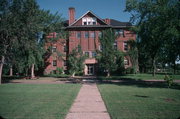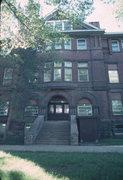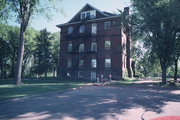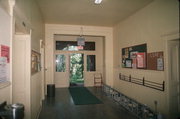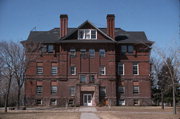Property Record
1411 ELLIS AVE
Architecture and History Inventory
| Historic Name: | Wheeler Hall, Northland College |
|---|---|
| Other Name: | Wheeler Hall |
| Contributing: | |
| Reference Number: | 2625 |
| Location (Address): | 1411 ELLIS AVE |
|---|---|
| County: | Ashland |
| City: | Ashland |
| Township/Village: | |
| Unincorporated Community: | |
| Town: | |
| Range: | |
| Direction: | |
| Section: | |
| Quarter Section: | |
| Quarter/Quarter Section: |
| Year Built: | 1893 |
|---|---|
| Additions: | |
| Survey Date: | 1982 |
| Historic Use: | university or college building |
| Architectural Style: | Romanesque Revival |
| Structural System: | |
| Wall Material: | Brick |
| Architect: | H.p. Padley |
| Other Buildings On Site: | |
| Demolished?: | No |
| Demolished Date: |
| National/State Register Listing Name: | Wheeler Hall, Northland College |
|---|---|
| National Register Listing Date: | 9/13/1977 |
| State Register Listing Date: | 1/1/1989 |
| National Register Multiple Property Name: |
| Additional Information: | A 'site file' exists for this property. It contains additional information such as correspondence, newspaper clippings, or historical information. It is a public record and may be viewed in person at the State Historical Society, Division of Historic Preservation. A large and symmetrical three story building with basement and attic designed in the Richardsonian Romanesque style of red brick and brownstone by H.P. Padley a partner of Conover & Porter of Madison. A large Richardsonian arched entry marks the main north facade. Wheeler Hall is the original building of Northland College originally the Northland College, originally the North Wisconsin Academy of 1893. The building is mostly a copy of Scowville Hall of Beloit College. Northland College, with its environmentally focused curriculum, offers a model of sustainable living at its McLean Environmental Living and Learning Center. This energy-efficient building, constructed with recycled-content materials, actively monitors energy use to gauge the effectiveness of its solar and wind energy systems. A computerized system records energy use every five minutes to measure McLean’s annual savings. Solar roof panels, salvaged from the Milwaukee Zoo, pre-heat water for its efficient gas-boiler heating system. These photovoltaic panels and a wind turbine offset three percent of electrical use. A two-story greenhouse permits year-round herb and vegetable gardening for residents, and the landscaping uses low-maintenance, drought-tolerant native species that weather Ashland’s cold climate. The McLean Center, which fills a city block, resembles a row of cedar-sided houses with brownstone trim and various combinations of casement and sash windows. The brownstone was salvaged from Ashland’s old high school. Housing 112 beds for students in a combination of singles, doubles, and suites, the building purposely has no elevator, so students must use stairs. The interior features low-wattage lighting instruments, high r-factor windows, and energy-efficient insulation in walls and ceilings. Recycled milk jugs form bathroom dividers, and the doors and countertops are made of wheat straw, soybean husk, and sawdust composite board. |
|---|---|
| Bibliographic References: | ASHLAND DAILY PRESS 4/27/1995. SUPERIOR DAILY TELEGRAM 5/4/1995. Ashland Daily Press 7/8/1992. Eckert, Kathryn. Sandstone Buildings in the Lake Superior Region. Detroit: Wayne State University Press, 2000. Buildings of Wisconsin manuscript. |
| Wisconsin Architecture and History Inventory, State Historic Preservation Office, Wisconsin Historical Society, Madison, Wisconsin |

